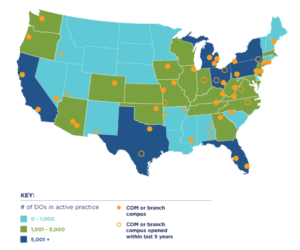Choosing to be a physician in the United States also means choosing between two types of degree programs: Doctor of Medicine (MD) or Doctor of Osteopathic Medicine (DO). Although most students attend traditional allopathic medical schools that offer an MD, there has been a recent surge in osteopathic medical schools that offer a DO. So what exactly is a DO and why is this one of the fastest-growing healthcare professions in the United States?
Philosophical Approach
MDs practice allopathic medicine, which means that they use treatments that aim to combat disease by use of remedies to overcome the effects of the disease. DOs practice osteopathic medicine, which is a more holistic approach. They are trained to consider a patient’s environment, nutrition, and body system as a whole when diagnosing and treating medical conditions. Osteopathic schools have a stronger focus on alternative therapies, holistic medicine, and disease prevention.
Educational Path
Both MD and DO physicians follow the same undergraduate academic path before taking the MCAT. They are required to attend 4 years of medical school and a residency program ranging from 3-7 years. MDs in the United States attend medical schools accredited by the Liaison Committee on Medical Education, whereas DOs attend schools accredited by the American Osteopathic Associate Commission.

There are currently 34 colleges of osteopathic medicine (COMs) nationwide, many of which have opened within the last 5 years. Osteopathic programs tend to be less competitive than allopathic medical schools, but both programs have similar curriculum and training.
DOs must complete an additional 200 hours of coursework in osteopathic manipulative medicine. This involves training in the musculoskeletal system, which is the body’s interconnected system of nerves, muscles, and bones. DOs use this treatment to perform osteopathic manipulative treatment (OMT), a series of hands-on techniques used to help diagnose illness or injury and facilitate the body’s natural tendency toward self-healing.
Both MD and DO physicians are licensed by the same state licensing boards and held to the same requirements for practicing medicine. To receive their medical license, MD students take the United States Medical Licensing Exam (USMLE) and DO students take the Comprehensive Medical Licensing Examination (COMLEX).
DO Profession Growth
There are currently over 100,000 active DOs nationwide, a number that has tripled in the last 30 years, according to the American Osteopathic Association.

One in four medical students in the U.S. attends an osteopathic medical school, with enrollment increasing approximately 25% every five years. If this trend continues, DOs are projected to represent more than 20% of all practicing physicians by 2030.
Specialties
Although both MD and DO physicians are found in every specialty medicine, most DOs tend to become primary care physicians, whereas MDs usually specialize in a specific area. The average annual wages of MDs are slightly higher than that of DOs, but this is mainly due to the specialization of MDs.

Conclusion
Although MDs and DOs have a different philosophical approach to medicine, both are licensed physicians who are similarly educated and certified. Deciding which path to pursue is ultimately up to you, but be sure to consider all of your options when applying for medical school. No matter which path you choose, becoming a medical scribe will greatly increase your chances of getting accepted into a professional program.
“2017 OMP Report.” American Osteopathic Association, American Osteopathic Association, 2018, osteopathic.org/about/aoa-statistics/.
Ahmed, Murtaza. “DO vs MD: What’s the Difference?” MyHeart, 9 Sept. 2018, myheart.net/articles/md-vs-do/.
Holland, Taylor Mallory. “DO vs. MD: What’s the Difference?” Prospective Students, David Geffen School of Medicine, 26 Apr. 2017, medschool.ucla.edu/body.cfm?id=1158&action=detail&ref=1019.


